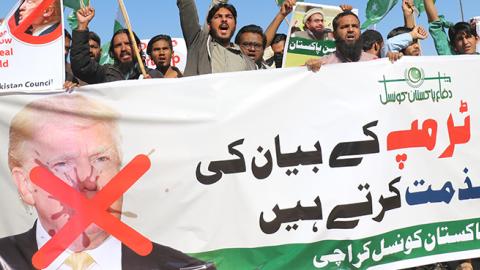p(firstLetter). The language of President Trump’s New Year’s Day tweet about Pakistan was undeniably, and undiplomatically, harsh: “The United States has foolishly given Pakistan more than 33 billion dollars in aid over the last 15 years, and they have given us nothing but lies & deceit, thinking of our leaders as fools,” Trump tweeted. “They give safe haven to the terrorists we hunt in Afghanistan, with little help. No more!”
Quibbles about his choice of words notwithstanding, the President’s tweet reflected dissatisfaction with the state of U.S.-Pakistan relations that dates back several decades. Indeed, his assertion that Pakistan is an unreliable ally is a historically grounded one, acknowledged even by those who insist that the United States has no alternative but to maintain an alliance with Pakistan. This “no alternative” argument has for too long held sway over American policymakers—and it is part of the reason Americans have had so much difficulty with Pakistan since the beginning of the two countries’ relationship in the early 1950s.
p(firstLetter). Most alliances are based on convergent interests or shared enemies. Allies occasionally disagree over tactics, methods, and operations, but are united by similar concerns. In Pakistan’s case, the United States signed up an ally whose principal enemy—India—was not America’s, and whose definition of its own interests has seldom converged with Washington’s.
Pakistan has undoubtedly been useful to the United States. It provided listening posts and an air base to spy over the Soviet Union during the 1950s and 1960s, served as the staging ground for jihad against the Soviets in Afghanistan during the 1980s, and has provided some intelligence and convenient supply routes for U.S. troops since 9/11. In return, the Pakistanis have received economic and military assistance. But transactional arrangements are never a substitute for shared interests and goals.
During the Cold War, critics of the U.S. alliance with Pakistan complained that Pakistan’s desire to fight India far outweighed its commitment to defeating communism. President Eisenhower’s ambassador to Pakistan, James M. Langley, expressed concern as early as 1957 about what he called “the Pakistan problem.” He noted that the country, then only ten years old, was becoming aid dependent, highly militarized, and focused exclusively on its competition with India. He worried that the United States was aggravating that dysfunction through its support for Pakistan.
Langley owned and edited the Concord Monitor newspaper in New Hampshire and did not share the preoccupations of bureaucrats in the Pentagon, the State Department, and the CIA. For those officials, the facilities Pakistan offered were worth their price in aid, especially since no other country in South Asia was prepared to provide a base for U.S. spy planes.
Langley fretted that American officials had “collectively developed certain generalizations about Pakistan” and had “proceeded to accept them as gospel truth without sufficient periodic scrutiny.” He described as “wishful thinking” the view that Pakistanis were pro-United States and pro-Western. It was obvious to him that Pakistan planned to use American military equipment only against India and that the U.S. military program in Pakistan was “based on a hoax”—the assumption that Pakistan needed weapons to confront the Soviet threat.
Langley’s fears were realized in 1965 when Pakistan initiated war with India and President Lyndon Johnson was forced to suspend military supplies in retaliation. This decision was the first to give rise to the sight of Pakistani protesters burning U.S. flags—but the United States did not give up on Pakistan. President Nixon supported it during the 1971 civil war that resulted in the creation of Bangladesh, and the transactional relationship muddled through until the Soviet occupation of Afghanistan.
This time, Americans returned to dole out military assistance and economic support in return for using Pakistan as the staging ground for creating a Vietnam-like situation for the Soviets. For once, there seemed to be a shared goal of forcing a Soviet withdrawal from Afghanistan, but soon the divergence in Pakistani and American interests grew once again.
The United States faced the fait accompli of a nuclear-armed Pakistan, partly facilitated by American officials who deemed a mujaheddin victory more important than preventing nuclear proliferation. Pakistan also diverted some of the resources provided by the Americans for Afghanistan towards insurgencies against India in Punjab and Kashmir.
More significantly, Pakistan planned for an Islamist Afghanistan that would provide it strategic depth against India instead of supporting the American objective of returning Afghanistan to a broad-based, stable non-communist government once the Soviets withdrew. Pakistan saw the Soviet withdrawal as an opportunity to expand jihad for regional influence and to gain leverage against India in the Kashmir dispute.
Pakistani support for terrorist groups has been a sore point in U.S.-Pakistan relations ever since. Turning Afghanistan into a satellite with the help of obscurantist proxies like the Taliban and the Haqqani Network has become an obsession for the all-powerful Pakistani military and intelligence services. Even blowback in the form of extremist attacks inside Pakistan has done nothing to alter that calculus.
After 9/11, the United States returned with a new bargain. It would pay Pakistan to fight the jihadis and to allow American use of Pakistan’s ground and air space to wage war against the Taliban in Afghanistan. Thus began the double game that Trump referred to in his candid tweet on New Year’s Day. Presidents Bush and Obama also understood the double game but they hoped that positive incentives, and occasional threats, would eventually change Pakistan’s strategic calculus.
p(firstLetter). President Trump appears willing to reconsider whether the U.S.-Pakistani alliance is worth preserving. Such reconsideration is also the demand of those Pakistanis who recognize their country’s dysfunction, which has been assisted by American largesse. Pakistan is the sixth largest nation in the world by population, has the sixth largest army and 11th most powerful military, but is only 25th by size of GDP on a purchasing power parity basis, and 42nd in terms of nominal GDP.
40 percent of Pakistan’s population cannot read or write. 57 percent of Pakistan’s adult population above the age of fifteen, 31 percent of Pakistani men, and 45 percent of Pakistani women remain illiterate. Pakistan is home to the third largest illiterate population globally, and there are only 15 countries in the world with a lower literacy rate.
The relatively small size of Pakistan’s economy makes it the smallest of any country that has tested nuclear weapons thus far, with the exception of North Korea. Furthermore, Pakistan suffers from massive urban unemployment, rural underemployment, and low per capita income. Approximately 60.3 percent of Pakistan’s population lives on less than $2 per day.
Nevertheless, Pakistan’s leaders insist on pursuing military competition with India, a country six times larger in population and ten times larger in terms of economic size, instead of addressing such massive problems at home. They are unlikely to revise their entrenched definition of the national interest any time soon. Similarly, the United States cannot accept the Pakistani military’s vision of Pakistani preeminence in South Asia or equality with India. The enemy and goals of the United States and Pakistan remain fundamentally mismatched.
The facilities and conveniences Pakistan offers the United States, such as the lines of communication for troops in Afghanistan or occasional intelligence about al-Qaeda, are also not worth more than the lives of Americans who are killed by the Taliban and Haqqani Network fighters possibly supported, or at least tolerated, by Pakistan’s military.
With fewer troops now on the ground in Afghanistan, the United States now has fewer supplies to transport; these can be flown in if Washington so chooses. In addition to ending the flow of aid, other instruments of U.S. policy towards Pakistan could include “hot pursuit” raids inside Pakistan, some broad economic sanctions, and targeted sanctions against ISI’s terrorism facilitators.
For all practical purposes, Pakistan and the United States are not allies, and the two countries need to explore ways to structure a non-allied relationship. The United States should be unambiguous in defining its interests and then acting on them, just as Islamabad has done for years.
A non-allied relationship need not be an adversarial one, though it would not preclude actions normally reserved for adversaries, such as targeted sanctions or military operations. It would involve cooperation where possible and a pre-determined quid pro quo. The United States would provide assistance on a conditional basis and pay for specific services, while being prepared to act unilaterally and without the deference normally due to allies.
Those voicing fears that walking away from Pakistan would result in it embracing China or acting against American interests must acknowledge that Pakistan is already as close to China as a country can be, and its actions already run counter to American interests. China has tried to reassure Pakistan after President Trump’s recent tweet by saying it knows of Pakistan’s suffering due to terrorism. The fact that it did not go further indicates its own concerns about Pakistan’s support and tolerance of jihadi groups, some of whom have also targeted China’s Muslims for recruitment.
Instead of rejecting the Trump Administration’s new approach over partisan considerations or personal dislike for the President, Americans must recognize the opportunity to break out of a situation that has vexed policymakers for decades.
The withdrawal of American subsidies for Pakistan’s pursuit of regional pre-eminence at the cost of its people is not just a wise course for Washington. It could also spark the serious and long overdue debate Pakistan needs at home about its prospects as a nation. Pakistan has the right to define its national interest as its leaders see fit, but the United States does not need to subsidize Pakistan’s pursuit of policies that do not advance American objectives.



















